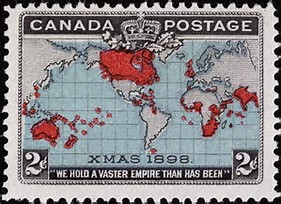The tradition of Christmas stamps was started in Canada in 1898 when Canadian postal officials decided to mark a reduction in the price of Imperial postage by issuing a commemorative stamp — a map of the world with the British empire in red and the inscription “XMAS 1898”.
Canada did not follow this up and there were no more stamps with Christmas themes until Austria in 1937 produced a stamp depicting Christmas roses and Brazil issued one in 1939 featuring the Three Wise Men and the Star. Neither of these stamps was issued specifically for Christmas and so, to philatelic purists, the honour of the first stamps issued for the holiday season with a Christmas theme is Hungary’s 1943 set of three depicting the Shepherds and Angels, the Nativity and the Adoration of the Magi. It was not until the late 1950s however that the use of special Christmas sets became widespread with Spain, Australia and the Vatican leading the way.
The first American Christmas stamp was issued in 1962, a 4-cent stamp showing a Christmas wreath. Given the touchy question of the separation of church and state in American political life it is not surprising that some criticized the post office for marking a religious observance but postal authorities were undeterred and have continued to issue Christmas stamps with both secular and religious themes. (Since 1993 political correctness has mandated that this distinction is one of “Holiday Contemporary” versus “Holiday Traditional” themes and the stamps’ only text is the inoffensive greeting: “Greetings”.)
It was customary in many countries to issue stamps at Christmas time with a surcharge that would direct money toward various charities and, in fact, in some places it was compulsory to use these stamps when sending seasonal mail. Cuba financed an anti-tuberculosis campaign in this way and Costa Rico funded a childrens’ home.
